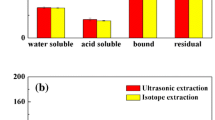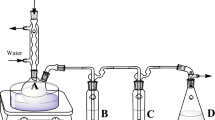Abstract
The effects of soil micro-particles and micro-pores on the release of total petroleum hydrocarbons (TPH) were investigated using long-term weathered, TPH-contaminated soil samples. The TPH concentrations were analyzed using various extraction schemes (i.e., total extraction, weak extraction, solvent extraction with or without ultrasound). The particle size distribution (<2 mm, 0.063–2 mm, <0.063 mm), micro-pore volume (<0.38 mm), and TPH fraction (C8–14, C16–28, C30–40) of selected samples were also determined to better understand the factors controlling TPH release from contaminated soils. TPH concentrations varied greatly among different fractions of each soil sample, but were highest in the micro-fraction (<0.063 mm) of each sample. In weathered soil samples, TPH was not only weakly or strongly adsorbed on soil particles, but also trapped in soil micro-pores. Moreover, heavier fractions of TPH were released slowly and lesser extent from contaminated soils. Results showed that the solvent extraction method with and without ultrasound could be used to assess relative binding strength of TPH to contaminated soils. These findings imply that to achieve a remediation goal, some contaminated soils require only relatively mild extraction with solvent, but soils with TPH trapped in micro-pores require physical destruction along with chemical extraction.




Similar content being viewed by others
References
Abdel-Moghny, T., Mohamed, R. S. A., El-Sayed, E., Mohammed Aly, S., & Snousy, M. G. (2012). Effect of Soil Texture on Remediation of Hydrocarbons-Contaminated Soil at El-Minia District, Upper Egypt. ISRN Chemical Engineering 2012, Article ID 406598, p 13.
Das, N., & Chandran, P. (2011). Microbial Degradation of Petroleum Hydrocarbon Contaminants: An Overview. Biotechnology Research International 2011, Article ID 941810, p 13
Duan, L. C., Naidu, R., Liu, Y. J., Palanisami, T., Dong, Z. M., Mallavarapu, M., et al. (2015). Effect of ageing on benzo[a]pyrene extractability in contrasting soils. Journal of Hazardous Materials, 296, 175–184.
Feng, D., & Aldrich, C. (2000). Sonochemical treatment of simulated soil contaminated with diesel. Advances in Environmental Research, 4(2), 103–112.
Heath, J. S., Koblis, K., & Sager, S. L. (1993). Review of chemical, physical, and toxicologic properties of components of total petroleum hydrocarbons. Journal of Soil Contamination, 2(1), 1–25.
Hutcheson, M. S., Pedersen, D., Anastas, N. D., Fitzgerald, J., & Silverman, D. (1996). Beyond TPH: health-based evaluation of petroleum hydrocarbon exposures. Regulatory Toxicology and Pharmacology, 24(1), 85–101.
Hyun, S., Ahn, M. Y., Zimmerman, A. R., Kim, M., & Kim, J. G. (2008). Implication of hydraulic properties of bioremediated diesel-contaminated soil. Chemosphere, 71(9), 1646–1653.
Kim, Y. U., & Wang, M. C. (2003). Effect of ultrasound on oil removal from soils. Ultrasonics, 41(7), 539–542.
Lowell, S., Shields, J. E., Thomas, A., & Thommes, M. (2004). Characterization of porous solids and powders: Surface area, pore size, and density. Springer Science & Business Media
Luthy, R. G., Aiken, G. R., Brusseau, M. L., Cunningham, S. D., Gschwend, P. M., Pignatello, J. J., et al. (1997). Sequestration of hydrophobic organic contaminants by geosorbents. Environmental Science & Technology, 31(12), 3341–3347.
Nasehi, S. A., Uromeihy, A., Nikudel, M. R., & Morsali, A. (2016). Influence of gas oil contamination on geotechnical properties of fine and coarse-grained soils. Geotechnical and Geological Engineering, 34(1), 333–345.
Peters, C. A., Knightes, C. D., & Brown, D. G. (1999). Long-term composition dynamics of PAH-containing NAPLs and implications for risk assessment. Environmental Science & Technology, 33(24), 4499–4507.
Ritchie, G. D., Still, K. R., Alexander, W. K., Nordholm, A. F., Wilson, C. L., Rossi, J., & Mattie, D. R. (2001). A review of the neurotoxicity risk of selected hydrocarbon fuels. Journal of Toxicology and Environmental Health, Part B, 4(3), 223–312.
Semple, K. T., Morriss, A. W. J., & Paton, G. I. (2003). Bioavailability of hydrophobic organic contaminants in soils: fundamental concepts and techniques for analysis. European Journal of Soil Science, 54(4), 809–818.
Shang, J., Liu, C., Wang, Z., & Zachara, J. M. (2011). Effect of grain size on uranium(VI) surface complexation kinetics and adsorption additivity. Environmental Science & Technology, 45(14), 6025–6031.
Siddique, T., Rutherford, P. M., Arocena, J. M., & Thring, R. W. (2006). A proposed method for rapid and economical extraction of petroleum hydrocarbons from contaminated soils. Canadian Journal of Soil Science, 86(4), 725–728.
Son, Y., Nam, S., Ashokkumar, M., & Khim, J. (2012). Comparison of energy consumptions between ultrasonic, mechanical, and combined soil washing processes. Ultrasonics Sonochemistry, 19(3), 395–398.
Torres, L. G. B., Climent, M., Saquelares, J., Bandala, E. R., Urquiza, G., & Iturbe, R. (2007). Characterization and treatability of a contaminated soil from an oil exploration zone. International Journal of Environmental Science and Technology, 4(3), 311–322.
Trindade, P. V. O., Sobral, L. G., Rizzo, A. C. L., Leite, S. G. F., & Soriano, A. U. (2005). Bioremediation of a weathered and a recently oil-contaminated soils from brazil: a comparison study. Chemosphere, 58(4), 515–522.
Wang, X., Feng, J., & Zhao, J. (2010). Effects of crude oil residuals on soil chemical properties in oil sites, Momoge Wetland, China. Environmental Monitoring and Assessment, 161(1–4), 271–280.
Wang, Z., Xu, Y., Zhao, J., Li, F., Gao, D., & Xing, B. (2011). Remediation of petroleum contaminated soils through composting and rhizosphere degradation. Journal of Hazardous Materials, 190(1–3), 677–685.
Acknowledgements
We thank Jaeseon Park and Daehoon Lee, for help with the soil micro-pore and TPH analyses, respectively. YHH was supported by the National Research Foundation of Korea Grant funded by the Korean Government (MEST) (2013, University-Institute cooperation program). This work was also supported by the KIST—Gangneung Institute (Grant no. 2Z04221) and Korea Ministry of Environment as The GAIA Project-2013000540005.
Author information
Authors and Affiliations
Corresponding author
Electronic supplementary material
Below is the link to the electronic supplementary material.
Fig. S1
(DOCX 42 kb)
Rights and permissions
About this article
Cite this article
Kwon, M.J., Lee, G., Hwang, Y.H. et al. Effects of Soil Micro-particles and Micro-pores on Petroleum Hydrocarbons Released From Contaminated Soils During Solvent Extraction with Ultrasound. Water Air Soil Pollut 227, 357 (2016). https://doi.org/10.1007/s11270-016-3071-0
Received:
Accepted:
Published:
DOI: https://doi.org/10.1007/s11270-016-3071-0




